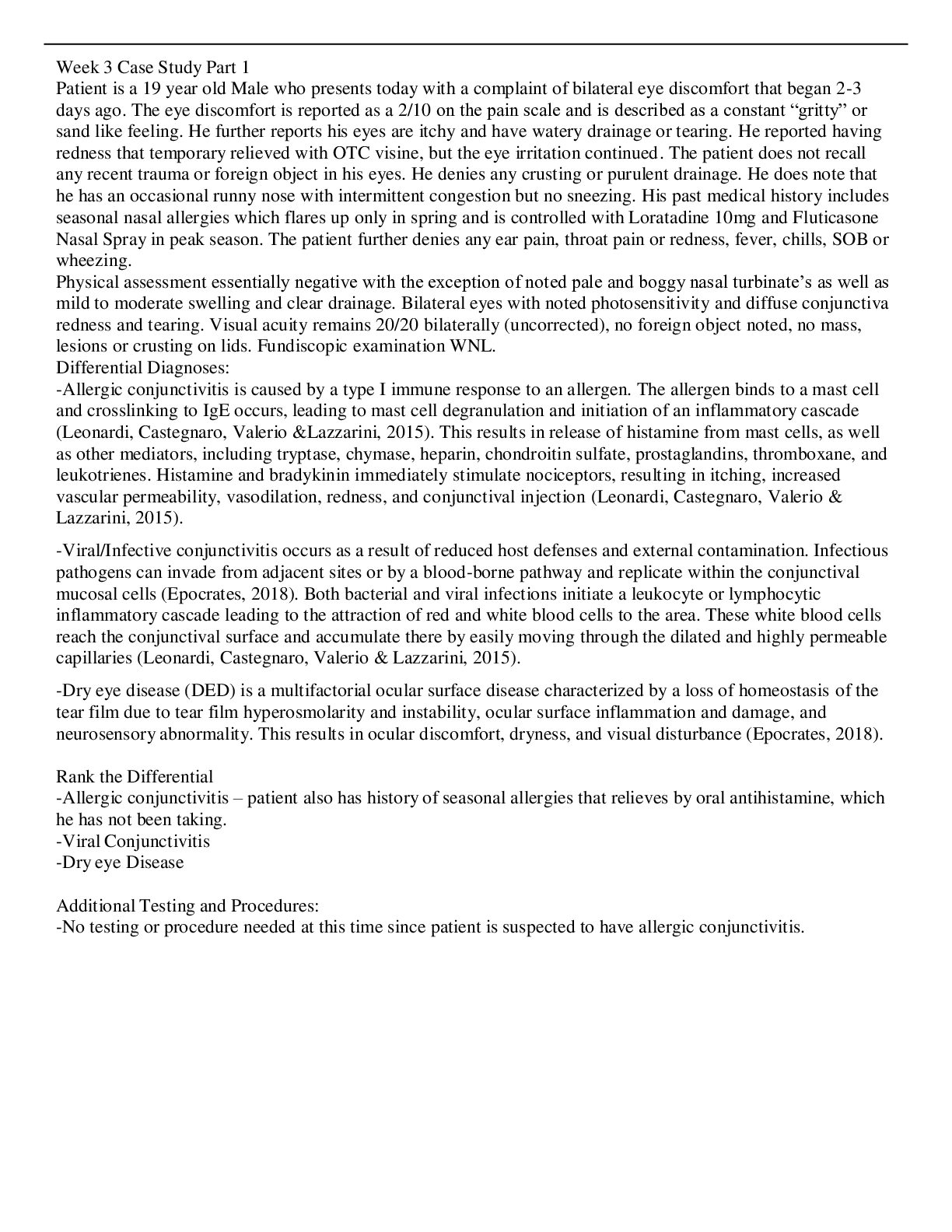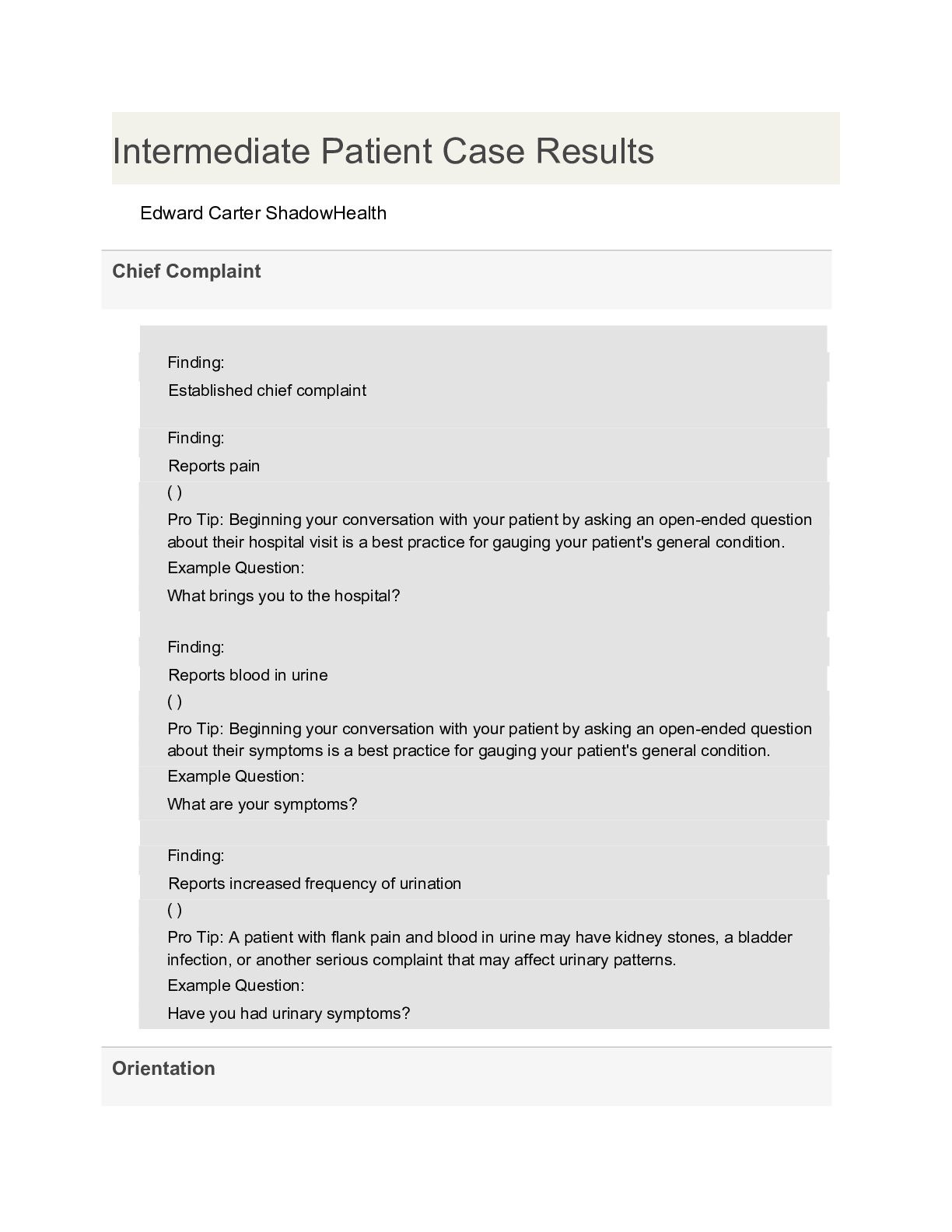*NURSING > CASE STUDY > Chamberlain College of NursingNR 511NR511 W3 Case study (All)
Chamberlain College of NursingNR 511NR511 W3 Case study
Document Content and Description Below
Week 3 Case Study Part 1 Patient is a 19 year old Male who presents today with a complaint of bilateral eye discomfort that began 2-3 days ago. The eye discomfort is reported as a 2/10 on the pain s... cale and is described as a constant “gritty” or sand like feeling. He further reports his eyes are itchy and have watery drainage or tearing. He reported having redness that temporary relieved with OTC visine, but the eye irritation continued. The patient does not recall any recent trauma or foreign object in his eyes. He denies any crusting or purulent drainage. He does note that he has an occasional runny nose with intermittent congestion but no sneezing. His past medical history includes seasonal nasal allergies which flares up only in spring and is controlled with Loratadine 10mg and Fluticasone Nasal Spray in peak season. The patient further denies any ear pain, throat pain or redness, fever, chills, SOB or wheezing. Physical assessment essentially negative with the exception of noted pale and boggy nasal turbinate’s as well as mild to moderate swelling and clear drainage. Bilateral eyes with noted photosensitivity and diffuse conjunctiva redness and tearing. Visual acuity remains 20/20 bilaterally (uncorrected), no foreign object noted, no mass, lesions or crusting on lids. Fundiscopic examination WNL. Differential Diagnoses: -Allergic conjunctivitis is caused by a type I immune response to an allergen. The allergen binds to a mast cell and crosslinking to IgE occurs, leading to mast cell degranulation and initiation of an inflammatory cascade (Leonardi, Castegnaro, Valerio &Lazzarini, 2015). This results in release of histamine from mast cells, as well as other mediators, including tryptase, chymase, heparin, chondroitin sulfate, prostaglandins, thromboxane, and leukotrienes. Histamine and bradykinin immediately stimulate nociceptors, resulting in itching, increased vascular permeability, vasodilation, redness, and conjunctival injection (Leonardi, Castegnaro, Valerio & Lazzarini, 2015). -Viral/Infective conjunctivitis occurs as a result of reduced host defenses and external contamination. Infectious pathogens can invade from adjacent sites or by a blood-borne pathway and replicate within the conjunctival mucosal cells (Epocrates, 2018). Both bacterial and viral infections initiate a leukocyte or lymphocytic inflammatory cascade leading to the attraction of red and white blood cells to the area. These white blood cells reach the conjunctival surface and accumulate there by easily moving through the dilated and highly permeable capillaries (Leonardi, Castegnaro, Valerio & Lazzarini, 2015). -Dry eye disease (DED) is a multifactorial ocular surface disease characterized by a loss of homeostasis of the tear film due to tear film hyperosmolarity and instability, ocular surface inflammation and damage, and neurosensory abnormality. This results in ocular discomfort, dryness, and visual disturbance (Epocrates, 2018 [Show More]
Last updated: 2 years ago
Preview 1 out of 4 pages

Buy this document to get the full access instantly
Instant Download Access after purchase
Buy NowInstant download
We Accept:

Reviews( 0 )
$10.00
Can't find what you want? Try our AI powered Search
Document information
Connected school, study & course
About the document
Uploaded On
Sep 13, 2021
Number of pages
4
Written in
Additional information
This document has been written for:
Uploaded
Sep 13, 2021
Downloads
0
Views
109



.png)









